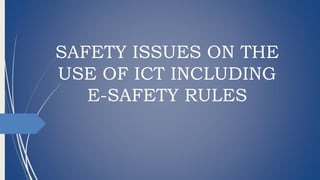
JOVEN LOPEZ(PPT, TECHNOLOGY).pptx
- 1. SAFETY ISSUES ON THE USE OF ICT INCLUDING E-SAFETY RULES
- 2. Using technology is not a risk by itself, but how it is used will be vulnerable to risks. When improperly used, it will pose danger to the users in school and at home. What are the safety issues that are needed to be addressed by safety policy and guidelines? As future teachers, do you need to know all of these?
- 3. Some Risks in the Use of ICT and e- Networking Technology is a phenomenon that seems to be uncontrollable. Despite the so many benefits for teaching and learning, there are also negative effects or influence on the learners. Hence as future teachers you have to be aware of how to safeguard learners in the school communities where they spend most of their waking hours and also in their homes or facilities that provide opportunities to use digital technologies like Internet Cafes. Safeguard and protection should be the primordial role of parents, teachers and schools. There are so many risks that we have to be aware of in the use of digital technologies. These may include the following:
- 4. 1. Exposure to inappropriate content, including on-line pornography, extremism (exposure to violence associated with racist language); 2. Lifestyle websites like self –harms and suicide sites, and hate sites; 3. Cyber-bullying in all forms, receiving sexually explicit images or messages; 4. Privacy issues including disclosure of personal information; 5. Health and well being (amount of time spent on-line, internet gaming and many more; 6. Prolonged exposure to on-line technologies, particularly at an early age; 7. Addiction to gambling and gaming; 8. Theft and fraud from activities such us phishing; 9. Viruses, Trojans, spyware and other malware; and 10. Social pressure to maintain online networks via texting and social networking sites.
- 5. Minor Misuse of ICT In school, some minor misuse made by learners include the following: • Copying information into assignment and failing to acknowledge the source (plagiarism and copyright infringement) • Downloading materials not relevant to their studies • Misconduct associated with subject logins, such as using someone else’s password • Leaving a mobile phone turned on during class period • Unauthorized taking of pictures or images with mobile phone camera, still or moving
- 6. e-Safety With all of the above concerns and many more, how do we confront all of these so as to protect our future generation? e-safety takes care not only of internet technologies but also of electronic communications via mobile phones, games consoles and wireless technology. It highlights the need to educate children and young people about the benefits, risks and responsibilities of using information technology. Here are some issues of e-safety: • e-safety helps safeguard children and young people in the digital world; • e-safety emphasizes learning to understand and new technologies in a positive way; • e-safety educates children about the risks as well as the benefits so we can feel confident online; and • e-safety supports young learners and adults to develop safer online behaviors, both in and out of school.
- 7. Network Management 1. Safety in the Use of Network in schools 1.1. Make clear that no one should log on as another user. 1.2. Require all users to always log off when they have finished working. 1.3. Maintain equipment to ensure health and safety. 1.4. Provide students with access to content and resources through guided e-learning 1.5. Set up a clear disaster recovery system in place for critical data that include secure, remote back up of critical data. 1.6. Secure wireless network to appropriate standards suitable for educational use. 1.7. Install all computer equipment professionally and meet health and safety standards. 1.8. Review the school ICT system regularly with regard to health and safety and security.
- 8. 2. Password Policy 2.1. Only authorized users will have individual passwords. Users are not permitted to disclose their password unless they got permission from the owner or from the management. The equipment that keeps the personal information shall be locked when unattended to prevent unauthorized access. Computers should be set to a time out if they become unused for a certain period of time.
- 9. 3. Personal mobile phones and mobile devices 3.1. All mobile phones shall be kept away in a box away from the children or learners and access is only allowed at break time or at the end of classes or when needed during the class period.
- 10. 4. Cameras 4.1. Taking pictures only from parents or caregivers and not from any other family member or friend while the child attends class. 4.2. Any picture taken of children shall be on on cameras solely for the purpose.
- 11. Setting Up An Educational Technology Room Schools that plan to dedicate a room where the students can access technologies for learning should include the following basic safety rules: 1. Provide tiltable tables. These tables can be tilted and adjusted to the height of the users. 2. Provide anti-glare screen filters. 3. Provide adjustable chairs. 4. Provide foot support. 5. Make sure lighting is suitable. 6. Make sure work stations are not cramped. 7. Plan work at a computer so that there are frequent breaks.
- 12. More specifically safety rules that can reduce risk of accidents in the working stations should include: 1. No trailing wires across or around the room which people can trip on. 2. Electrical sockets should not be overloaded. 3. Electrical equipment should be safety-tested at least once a year. 4. There should be adequate space around desk for people to move. 5. Bags and obstacles should be stored out of the way. 6. Food and drinks should not be placed near machines. 7. Heating and ventilation should be suitable for the working environment. 8. Fire extinguishers should be available. 9. Fire exits should be clearly marked and free from clutter.
- 13. Thank you for listening, stay safe and God bless